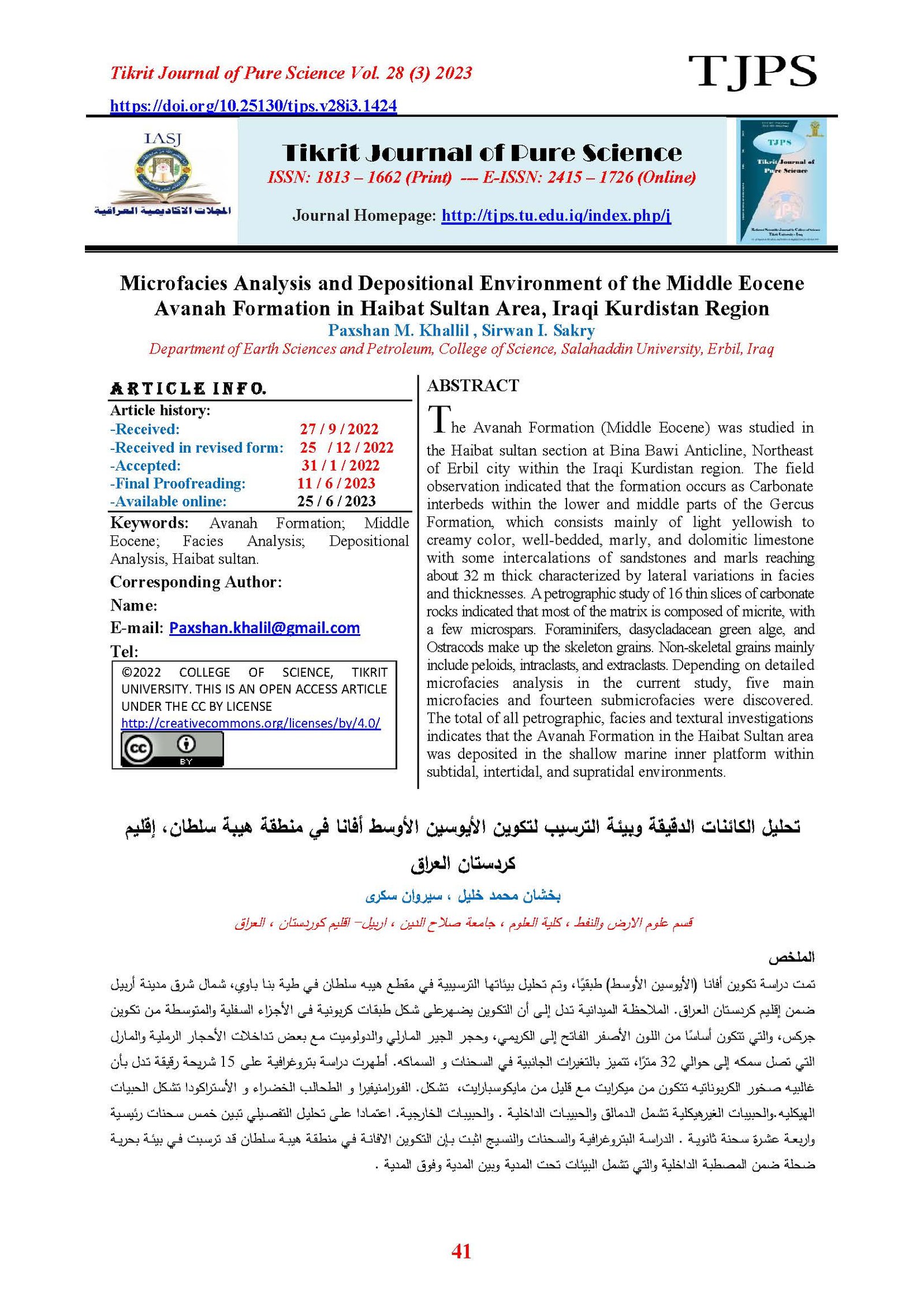Microfacies Analysis and Depositional Environment of the Middle Eocene Avanah Formation in Haibat Sultan Area, Iraqi Kurdistan Region
Main Article Content
Abstract
The Avanah Formation (Middle Eocene) was studied in the Haibat sultan section at Bina Bawi Anticline, Northeast of Erbil city within the Iraqi Kurdistan region. The field observation indicated that the formation occurs as Carbonate interbeds within the lower and middle parts of the Gercus Formation, which consists mainly of light yellowish to creamy color, well-bedded, marly, and dolomitic limestone with some intercalations of sandstones and marls reaching about 32 m thick characterized by lateral variations in facies and thicknesses. A petrographic study of 16 thin slices of carbonate rocks indicated that most of the matrix is composed of micrite, with a few microspars. Foraminifers, dasycladacean green alge, and Ostracods make up the skeleton grains. Non-skeletal grains mainly include peloids, intraclasts, and extraclasts. Depending on detailed microfacies analysis in the current study, five main microfacies and fourteen submicrofacies were discovered. The total of all petrographic, facies and textural investigations indicates that the Avanah Formation in the Haibat Sultan area was deposited in the shallow marine inner platform within subtidal, intertidal, and supratidal environments
Article Details

This work is licensed under a Creative Commons Attribution 4.0 International License.
Tikrit Journal of Pure Science is licensed under the Creative Commons Attribution 4.0 International License, which allows users to copy, create extracts, abstracts, and new works from the article, alter and revise the article, and make commercial use of the article (including reuse and/or resale of the article by commercial entities), provided the user gives appropriate credit (with a link to the formal publication through the relevant DOI), provides a link to the license, indicates if changes were made, and the licensor is not represented as endorsing the use made of the work. The authors hold the copyright for their published work on the Tikrit J. Pure Sci. website, while Tikrit J. Pure Sci. is responsible for appreciate citation of their work, which is released under CC-BY-4.0, enabling the unrestricted use, distribution, and reproduction of an article in any medium, provided that the original work is properly cited.
References
[1] Bellen, R.V., Dunnington, H.V., Wetzel, R. and Morton, D.M., (1959). Lexique stratigraphique international Asie. Iraq. Intern. Geol. Conger. Comm. Stratigr, 3, p.333.
[2] Buday, T. (1980) The Regional Geology of Iraq, Vol 1: Stratigraphy and Paleogeography. Publications of Geological Survey of Iraq, Baghdad, 445 p. 1 [3] Jassim, S.Z. and Buday, T., 2006. Late Tithonian–Early Turonian Megasequence AP 8 In: Jassim SZ and Goff JC (eds.) Geology of Iraq. Published by Dolin, Prague and Moravian Museum, Brno, pp.124-154. [4] Sinclair, H.D., (1997). Flysch to molasse transition in peripheral foreland basins: The role of the passive margin versus slab breakoff. Geology, 25(12), pp.1123-1126. [5] Al-Qayim, B., Omer, A. and Koyi, H., (2012). Tectonostratigraphic overview of the Zagros suture zone, Kurdistan region, Northeast Iraq. GeoArabia, 17(4), pp.109-156. [6] Baziany, M.M., 2014. Depositional systems and sedimentary basin analysis of the qulqula radiolarian formation of the zagros suture zone, sulaimani area, iraqi kurdistan region. Unpublished ph. D. Thesis, university of sulaimani. [7] Zainy, F. M. A. (2017). "Heavy metals in lipstick products marketed in Saudi Arabia." Journal of Cosmetics, Dermatological Sciences and Applications 7. (4) PP. 336-348. [8] Sherland P., Archer R., Casey D., Davies R., Hall, Heward A., Horbury A., Simmon M., (2001): Arabian plate sequencese stratigraphy. Geo Arab. Sp2. p 371 [9] Al-Hashimi, H.A and Amer, R.M., (1985) Tertiary Microfacies of Iraq. Directorate General for Geological and Mineral Investigation, Baghdad, 159 Pl. [10] Jassim, S.Z. and Goff, J.C. eds., (2006). Geology of Iraq. DOLIN, sro, distributed by Geological Society of London,251p [11] Al-Sakry, S.I., (1999). Stratigraphy and facies of Paleogene carbonate formations of selected sections, Northeastern Iraq. Unpublished M. Sc. thesis, Baghdad University, 113pp. [12] Erdem, N.Ö., Schlagintweit, F. and Sinanoğlu, D., (2021). Dictyoconus larger benthic foraminifera from the Middle-Upper Eocene of the Middle East. Turkish Journal of Earth Sciences, 30(2), pp.268-278. [13] Palmer, J.R., Hoffman, D., Stephenson, W.J., Odum, J.K. and Williams, R.A., (1997). Shallow seismic reflection profiles and geological structure in the Benton Hills, southeast Missouri. Engineering Geology, 46(3-4), pp.217-233. [14] Brasier, M.D. and Armstrong, H., 1980. Microfossils, London: G. Allen & Unwin. (p. 193). [15] Boggs Jr., S. (2006) Principles of Sedimentology and Stratigraphy. 4th Edition, Pearson Education Inc., Upper Saddle River, 662 p. [16] Maisch, M.W. and Reisdorf, A.G., (2006). Evidence for the longest stratigraphic range of a post-Triassic ichthyosaur; A Leptonectes tenuirostris from the Pliensbachian (Lower Jurassic) of Switzerland. Geobios, 39(4), pp.491-505.
[17] Flügel, E. and Flügel, E., (1982). Introduction to facies analysis. Microfacies Analysis of Limestones, pp.1-26. [18] Folk, R.L., 1962. Petrography and origin of the Silurian Rochester and McKenzie Shales, Morgan County, West Virginia. Journal of Sedimentary Research, 32(3), pp.539-578. [19] Flügel, E. and Munnecke, A., 2010. Microfacies of carbonate rocks: analysis, interpretation and application (Vol. 976, p. 2004). Berlin: springer.
[20] Dunham, R.J. (1962) Classification of Carbonate Rocks According to Depositional Texture, Pp 108,121 [21] Wilson, J.L. (1975) Carbonate Facies in Geologic History. Springer Verlag, New York, 471p [22] Burchette, T.P. and Wright, V.P., (1992). Carbonate ramp depositional systems. Sedimentary geology, 79(1-4), pp.3. [23] Burchette, T.P., Wright, V.P. and Faulkner, T.J., 1990. Oolitic sandbody depositional models and geometries, Mississippian of southwest Britain: implications for petroleum exploration in carbonate ramp settings. Sedimentary Geology, 68(1-2), pp.87-115. [24] Wright, P., 2006. FLÜGEL, E. 2004. Microfacies of Carbonate Rocks. Analysis, Interpretation and Application. xx+ 976 pp. Berlin, Heidelberg, New York: Springer-Verlag. Geological Magazine, 143(1), pp.137-138.
